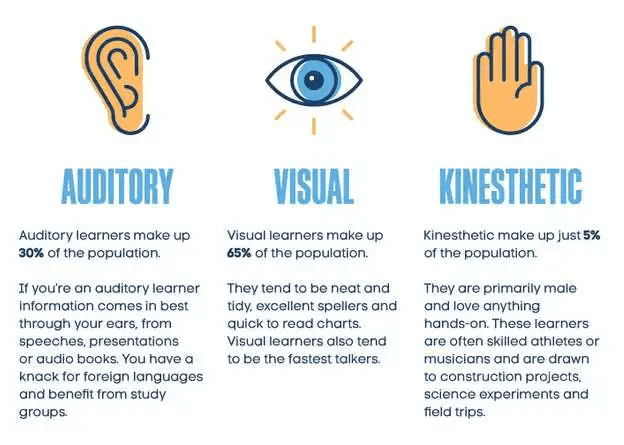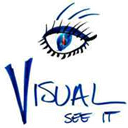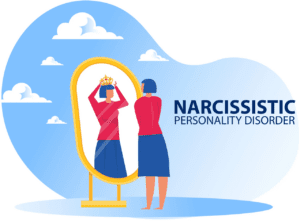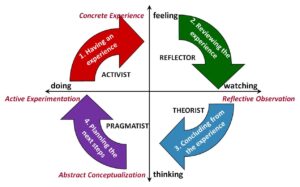What are the VAK Learning Styles?
The Visual, Auditory, and Kinesthetic Learning Styles, or VAK for short, learning model suggests that most people may have preferred learning styles.
People commonly have a preferred VAK Learning Style but often blend all three depending on the situation and subject matter.
When you understand the different VAK Learning Styles, you can better apply the one that best suits you.
There is no right or wrong learning style. The point is that some learning types suit your preferred learning style.
The VAK assessment is not a scientifically validated testing instrument but is designed to broadly indicate preferred learning styles.

Visual Learning Style

Someone with a Visual VAK Learning Style prefers seen or observed things, including pictures, diagrams, demonstrations, displays, handouts, films, flip charts, etc.
They will use phrases such as ‘show me, ”let’s look at that,’ and ‘best able to perform a new task after reading the instructions or watching someone else do it first.
And they will work from lists and written directions and instructions.
VAK Visual people learn through seeing.
- Highlight important points in the text.
- Use books on tapes.
- Use a tape recorder to tape lectures, presentations, directions, etc.
- Learn to use text glossaries, indexes, appendices, chapter summaries, etc.
- Preview texts.
Visual Style Traits
- The mind sometimes strays during verbal activities.
- Observe rather than act or talk.
- Likes to read.
- Usually, a good speller.
- Memories by seeing graphics or pictures.
- Not too distractible.
- Find verbal instruction difficult.
- Has good handwriting.
- Remembers faces.
- Uses advanced planning.
- Doodles.
- Quiet by nature.
- Meticulous, neat in appearance.
- Notices details.
Visual Style Habits
- Organize work and living space to avoid distractions.
- Sit in the front of the room to avoid distraction and away from doors or windows where the action takes place.
- Sit away from wall maps or bulletin boards.
- Use neatly organized or typed material.
- Use visual association, imagery, written repetition, flashcards, and clustering strategies for improved memory.
- Reconstruct images in different ways.
- Try other spatial arrangements and take advantage of blank spaces on the page.
- Use note pads, Post-Its, todo lists, and other reminders.
- Use organizational format outlining for recording notes.
- In your notes, use underlining and highlighting in different colors, symbols, flow charts, graphs, or pictures.
- Practice turning visual cues into words as you prepare for exams.
- Allow sufficient time for planning and recording thoughts when doing problem solving tasks.
- Use test preparation strategies emphasizing information organization, visual encoding, and recall.
- Participate actively in class or group activities.
- Develop written or pictorial outlines of responses before answering essay questions.
Visual Style Spelling
They recognize words by sight and rely on configurations of words.
Visual Style Reading
Visual people like descriptions.
They sometimes stop reading to stare into space, imagining the scene intensely.
Visual Style Handwriting
It tends to be good, particularly when young.
Spacing and size are good, and appearance is essential to them.
Visual Style Memory
They remember faces but forget names.
They like to write things down and take notes.
Visual Style Imagery
Vivid imagination; thinks in pictures; visualizes in detail.
Visual Style Distractibility
Unaware of sounds; distracted by movement.
Visual Style Problem-Solving
Deliberate; plans in advance; organizes thoughts by writing them; lists problems.
How Visual Learning Style Response to Periods of Inactivity
Stares or doodles; find something.
How Visual Learning Style Response to New Situations
Looks around or examines structure.
Visual Learning Style Advice
General Advice
- Take notes, pictures, graphs, and charts.
- Use flashcards and highlight critical details.
- Sit close to the teacher to watch their faces and gestures.
- Take notes or make lists as you listen to directions.
- Carefully check the instructions written on the chalkboard and handouts.
- As the teacher lectures, pay attention to visual aids such as drawings, maps, graphs, charts – transparency, posters, films, and books.
- Imagine pictures of the information you are supposed to remember.
- Use color coding to convey important information.
- When possible, read assignments silently.
- Maintain class notes and outlines of vital information to study.
- Try to read and study in a well-lit, quiet place.
- Record homework assignments in a date book, on a notepad, or a specially designed assignment sheet.
- Keep a notepad with you at all times.
- Write everything for frequent and quick visual review.
Spelling Advice
- See the word and close your eyes.
- Make a picture and then read from your picture.
- Write the word that matches the picture.
- Check your work immediately.
Reading Advice
- Use sight words, flashcards, note cards, and experience stories.
- Don’t try to sound words out; instead, determine if the new word or words have words you already know.
- For example, the word “systematic” includes the words “system,” “stem,” and “mat.”
- You are a “look-and-say” learner.
- Look at a word carefully, then say it.
Visual Style Writing Advice
- Jot down ideas as they form in your mind.
- Outline your ideas.
- Make a rough draft, skipping lines.
- Correct/revise your work.
- Re-coy your paper.
- ESSAY TEST: Make quick outlines on scratch paper or in the test’s margin before writing your answer.
Visual Style Mathematics Advice
- Visualize the problem.
- Make pictures or tallies of the problem on scratch paper.
- Write the problem.
Auditory Learning Style

Someone with an Auditory VAK Learning Style prefers transferring information through listening: to the spoken word, to self or others, and to sounds and noises.
They will use phrases such as ‘tell me’ and ‘let’s talk it over’ and be best able to perform a new task after listening to instructions from an expert.
They are happy being given spoken instructions over the telephone and can remember all the words to songs they hear!
They learn best through verbal lessons, discussions, talking, and listening to others.
Auditory learners interpret the underlying meanings of speech by listening to the tone of voice, pitch, and speed.
Written information may have little meaning until it is heard.
These learners often benefit from reading text aloud and using a tape recorder.
VAK Auditory people learn through listening.
- Discuss their ideas.
- Work in study groups.
- Recite information that is important to remember.
- Review printed material before auditory information is presented.
- Repeat back instructions just heard to check clarity.
Auditory Style Traits
- Talks to self aloud.
- Enjoys talking.
- They are easily distracted.
- Has difficulty with written directions.
- Likes to be read to.
- Memorizes sequentially.
- Enjoys music.
- Whispers to self while reading.
- They are distracted by noise.
- Hums or sings.
- Outgoing by nature.
- Enjoys listening activities .
Auditory Style Habits
- Work in quiet areas to reduce distractions, avoiding areas with conversation, music, and television.
- Sit away from doors or windows where noises may enter the classroom.
- Rehearse information orally.
- Attend lectures and tutorials regularly.
- Discuss topics with other students, professors, and GTAs. Ask others to hear your understanding of the material.
- Use mnemonics, rhymes, jingles, and auditory repetition through tape recording to improve memory.
- Practice verbal interaction to improve motivation and self monitoring.
- Use tape recorders to document lectures for reading materials.
- Remember to examine illustrations in textbooks and convert them into verbal descriptions.
- Read the directions for tests or assignments aloud or have someone read them to you, especially if they are lengthy and complicated.
- Remind yourself to review the details.
- Use time managers and translate written appointment reminders into verbal cues.
- Use verbal brainstorming and tape recording writing and proofing.
- Leave spaces in your lecture notes for later recall and filing.
- Expand your notes by talking with others and collecting notes from the textbook.
- Read your notes aloud.
- Practice writing your answers using old exams and speaking your answers.
Auditory Style Spelling
They use a phonics approach and have auditory word attack skills.
Auditory Style Reading
Enjoys dialogue and plays; avoids lengthy descriptions; unaware of illustrations; moves lips or sub-vocalizes.
Auditory Style Handwriting
Has more difficulty learning in initial stages; tends to write lightly.
Auditory Style Memory
They remember names but forget faces and remember by auditory repetition.
Auditory Style Imagery
Sub-vocalizes; imagines things in sounds; details are less important.
Auditory Style Distractibility
Easily distracted by sounds.
Auditory Style Problem-Solving
They like to discuss problems and find solutions verbally or sub-vocally.
Auditory people tend to talk themselves through problems.
How Auditory Learning Style Response to Periods of Inactivity
They often hum and talk to themselves or others.
How Auditory Learning Style Response to New Situations
Talks about the situation; discusses pros and cons of what to do.
Auditory Learning Style Advice
General Advice
- Say aloud the information to be learned/have someone read it to you/read it into a tape recorder and replay it.
- Read your work out loud.
- Summarize what you have read on tape.
- Say words inside your head silently.
- Brainstorm ideas with others.
- Form study groups.
- Learn information through tapes, television, oral reports, rhymes and songs, radio, lectures, book reviews, panel and group discussions, guest lectures, and said questions and answers.
- Use a straight-edge marker or guide to help you stay where you are while reading or working with printed materials.
- Tape class lectures (Ask the instructor for permission).
- Meet with classmates before and after class to discuss the material.
Spelling Advice
- Listen to the spelling of the word.
- Say the word – then say each letter out loud.
- Close your eyes and spell the word out loud; check your spelling.
- Close your eyes and spell the word out loud again; check your spelling.
- Now, write the word, trying to hear it in your mind.
- Verbally review spelling words and lectures with a friend.
Writing Advice
- Plan each sentence you want to write by saying it aloud or silently in your head.
- Say each sentence several times.
- Write each sentence as you say it, or talk into a tape recorder, dictating each sentence of your paragraph; then play the tape back – one sentence at a time – and record it in writing.
Mathematics Advice
- Learn math aloud by saying the concept, fact, theorem, etc.
- Explain math problems, concepts, facts, etc., to yourself, relating the information out loud.
- Use a tape recorder and replay the information.
Kinaesthetic (Tactile) Learning Style

Someone with a Kinaesthetic VAK Learning Style prefers physical experience – touching, feeling, holding, doing, and practical hands-on experiences.
They will use phrases such as “Let me try and How do you feel?” and will be best able to perform a new task by going ahead and trying it out, learning as they go.
And they like to experiment hands-on and never look at the instructions first!
VAK Kinesthetic learners learn best through a hands-on approach, actively exploring the physical world around them.
They may find it hard to sit still for long periods and may become distracted by their need for activity and exploration.
VAK Kinaesthetic people learn through moving, doing, and touching.
- Take frequent study breaks.
- Work in a standing position.
- Listen to music while they study.
- Bring some “grip toy” to class to hold on to.
- Skim through reading material to get a rough idea of what it is about before reading it in detail.
Kinaesthetic Style Traits
- Likes physical rewards.
- In motion most of the time.
- Likes to touch people when talking.
- Taps pencil or foot when studying.
- They enjoy doing activities.
- Reading is not a priority.
- Poor speller.
- Likes to solve problems by physically working through them.
- They will try new things.
- Outgoing by nature; expresses emotions by physical means.
- Uses hands while talking.
- Dresses for comfort.
Kinaesthetic Style Habits
- Keep verbal discourse short and to the point. Actively participate in discussions.
- Use your senses sight, touch, taste, smell, and hearing.
- Direct involvement, physical manipulation, imagery, and “hands-on” activities can improve motivation, interest, and memory.
- Organize information into the steps to physically complete a task.
- Seek courses with laboratories, field trips, etc., and lecturers who give real-life examples.
- Use case studies and applications (examples) to help with principles and abstract concepts.
- Allow for physical action in solving problems.
- Read or summarize lengthy and complicated directions to discourage starting a task without instructions.
- Use taped reading materials.
- Use practice, play-acting, and modeling to prepare for tests.
- Allow for physical movement and periodic breaks during tests, reading, or composing written assignments.
- Roleplay the exam situation.
- Teach the material to someone else.
- Write practice answers, paragraphs, or essays.
Kinaesthetic Style Spelling
A poor speller often writes words to determine if they “feel” right.
Kinaesthetic Style Reading
They prefer stories where the action occurs early and fidgets while reading; they are not an avid reader.
Kinaesthetic Style Handwriting
Good initially, but deteriorates when space becomes smaller; push harder on writing instrument.
Kinaesthetic Style Memory
Remembers best what was done but not what was seen or talked about.
Kinaesthetic Style Imagery
Imagery is not necessary; images that do occur are accompanied by movement.
Kinaesthetic Style Distractibility
Not attentive to visual or auditory presentation, so may seem distracted.
Kinaesthetic Style Problem-Solving
Attacks problem physically; impulsive; often selects solution involving most significant activity.
How Kinaesthetic Learning Style Response to Periods of Inactivity
Fidgets or finds reasons to move.
How Kinaesthetic Style Response to New Situations
Tries things out; touches, feels, or manipulates.
Kinaesthetic Learning Style Advice
- Keep your desk clear of distracting objects.
- Cover the page you’re not reading.
- If you are distracted by noise, turn off the radio; wear earplugs or earphones in the learning center to block the noise.
- If you want sound, listen to soft music.
- Divide your work into short study sessions.
- Get a timer. After 20 minutes, or when a task is completed, give yourself a reward, such as a cookie, a walk around the block, listening to one song, etc.
- Sit as close to the teacher as possible, or sit in the center of the room by quiet students.
- Use a multi-sensory approach (hearing, seeing, touching, and doing) as much as possible.
- Get plenty of sleep.
- Eat a nutritious breakfast and lunch.
- Snack on fruit or nutritional food if you need extra energy.
- Study in a carrel or an office with a desk for your textbooks and notebook.
- Use models, natural objects, and materials that can be touched and moved.
- For example, learn geography by handling and studying a globe.
- Draw what you are learning.
- Trace spelling words as you practice them.
- Record in writing information learned.
- Keep a paper supply on hand.
- Roleplay, type, take notes, or construct models to learn the information.



